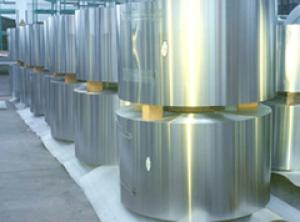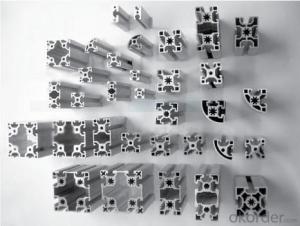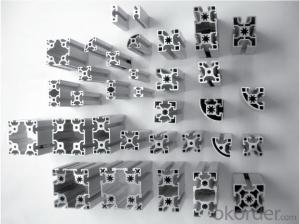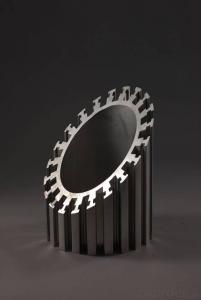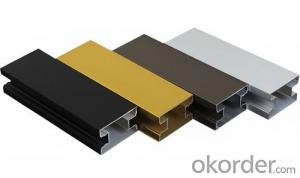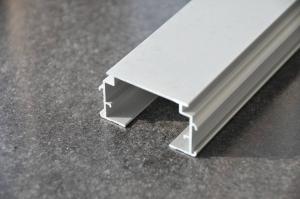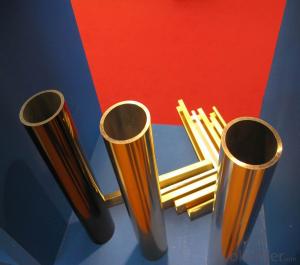Aluminum Tube Profiles for Electronics
- Loading Port:
- China Main Port
- Payment Terms:
- TT OR LC
- Min Order Qty:
- -
- Supply Capability:
- -
OKorder Service Pledge
OKorder Financial Service
You Might Also Like
It mainly consists of those for electric home appliances series, electronics series and electric power series. The aluminum products for electronic industry remain with the high-tech content products; in the middle term of 1990s, the high, medium, low voltage of anode foils & cathode foils entirely rely on the import, consequently it generated a severe influence on competitiveness of the industry, SWA put a great deal of efforts in manpower and material resources to carry out developing and marketing successfully at the end of 1990s, which acquired affirmative comments. The products are applied specifically for buses, stringing, conductors, electrical elements, refrigerators, air-conditioners, cables etc.
Aluminum foil produced by SWA for air-conditioner has good property of deep drawing with high strength and elongation, which has reached the standard of similar imported products.
The Al foil for high performance electrolytic capacitor has been filling a vacancy domestically in China, the integrated quality of products have been approaching or reaching to the world advanced level of similar products.
The Al foils for electrolytic capacitor (1997), the aluminum foil for radiating of air-conditioner (2001) are entitled as “Famous Brand Product of Chongqing”.
- Q: This question asks for various methods of producing aluminum profiles in a manner that is both efficient and cost-effective.
- <p>Efficient and cost-effective manufacturing of aluminum profiles can be achieved through several methods: 1) Using advanced extrusion technology, which is the primary method for shaping aluminum profiles, allows for high production rates and consistent quality. 2) Implementing automation in the production process to reduce labor costs and increase output. 3) Employing recycling techniques to use scrap aluminum, which lowers material costs and is environmentally friendly. 4) Optimizing the design of profiles to reduce material usage without compromising strength. 5) Utilizing energy-efficient equipment and processes to minimize energy consumption. 6) Regular maintenance and upgrading of machinery to ensure operational efficiency and reduce downtime. 7) Implementing just-in-time inventory management to minimize storage costs and reduce waste. 8) Continuous improvement through research and development to find new, more efficient methods of production.</p>
- Q: Are aluminum profiles suitable for constructing railings or staircases?
- <p>Yes, aluminum profiles are commonly used for railings and staircases due to their strength, durability, and low maintenance requirements. They offer a modern aesthetic and are resistant to corrosion, making them ideal for both indoor and outdoor applications. Aluminum profiles can be easily customized to fit various designs and can be powder-coated or anodized for enhanced visual appeal and protection against the elements.</p>
- Q: This question asks for a method to determine the quantity of aluminum profiles required for a specific project.
- <p>To calculate the amount of aluminum profiles needed for a project, first, determine the dimensions and design of the structure. Measure the length, width, and height of the required profiles. Consider the number of profiles needed for each section of the project. Multiply the length of each profile by the number of profiles required. Sum these totals for all sections to get the overall amount of aluminum needed. Factor in a margin for cutting and waste to ensure you have enough material. Consult with suppliers or use specialized software for more precise calculations, especially for complex projects.</p>
- Q: What are the different bending and forming options for aluminum profiles?
- There are several bending and forming options available for aluminum profiles, each with its own advantages and applications. Some of the common methods include: 1. Cold bending: This is a widely used process that involves bending the aluminum profile using external force without the use of heat. Cold bending can be done manually or with the help of machinery such as press brakes or rollers. It is suitable for creating simple shapes and can be cost-effective for low volume production. 2. Heat bending: In this method, the aluminum profile is heated to a specific temperature, which makes it more malleable and easier to bend. Heat bending is often used for complex or precise shapes that cannot be achieved through cold bending. It requires specialized equipment, such as heating lamps or furnaces, and skilled operators to ensure accurate results. 3. Roll forming: This process involves passing the aluminum profile through a series of rollers to gradually shape it into the desired form. Roll forming is suitable for creating continuous shapes or long lengths of profiles with consistent dimensions. It is commonly used in industries such as construction, automotive, and furniture manufacturing. 4. Stretch forming: Stretch forming is a method that involves clamping the aluminum profile at its edges and stretching it over a form or mold. This process allows for the creation of complex curves and contours, making it ideal for applications that require intricate designs or unique shapes. Stretch forming is commonly used in aerospace, architectural, and automotive industries. 5. Hydroforming: Hydroforming uses pressurized fluid to shape the aluminum profile into a mold. The fluid pressure forces the metal to conform to the shape of the mold, resulting in precise and high-quality formed parts. Hydroforming is particularly advantageous for creating lightweight and structurally efficient components, making it popular in the automotive and aerospace industries. These bending and forming options provide a range of possibilities for shaping aluminum profiles to meet specific design requirements. The choice of method depends on factors such as the complexity of the desired shape, production volume, cost considerations, and the specific industry application.
- Q: Are aluminum profiles suitable for use in sustainable or eco-friendly construction projects?
- <p>Yes, aluminum profiles can be used for green building projects. They are valued for their recyclability, which contributes to sustainability. Aluminum is lightweight, strong, and requires less energy to produce and transport compared to other materials like steel. Additionally, aluminum's durability can lead to a longer lifespan, reducing the need for frequent replacements and thus minimizing waste. Moreover, aluminum can be used in energy-efficient designs, such as in window frames that provide better insulation, further enhancing the green credentials of a building.</p>
- Q: This question asks about the various standards and specifications that govern the manufacturing and quality of aluminum profiles.
- <p>Aluminum profiles are governed by a variety of standards and specifications that ensure quality and consistency. These include international standards such as ISO 7599, which specifies tolerances for aluminum profiles, and ASTM B221, which covers aluminum and aluminum-alloy extruded bars, rods, and profiles. National standards like the European EN 573 or the Chinese GB/T 6892 also provide guidelines for aluminum profiles. Specifications cover dimensions, mechanical properties, surface finishes, and tolerances. Each standard may have specific requirements for different types of profiles, such as those used in construction, automotive, or aerospace industries. Compliance with these standards is crucial for ensuring the safety, performance, and reliability of aluminum profiles in various applications.</p>
- Q: This question asks if aluminum profiles can be utilized for constructing interior partitions or walls within a building.
- <p>Yes, aluminum profiles can be used for interior partitions or walls. They are lightweight, durable, and offer excellent resistance to corrosion. Aluminum profiles are easy to install and can be used in various configurations, making them suitable for both residential and commercial spaces. They also provide good thermal insulation and can be combined with other materials like glass or fabric for aesthetic and functional purposes.</p>
- Q: Can aluminum profiles be used for access platforms?
- Yes, aluminum profiles can be used for access platforms. Aluminum is a lightweight and durable material that is commonly used in various industrial applications, including access platforms. It offers high strength-to-weight ratio, corrosion resistance, and easy fabrication, making it an ideal choice for constructing access platforms that need to be strong, stable, and long-lasting.
- Q: Are aluminum profiles weather-resistant?
- Yes, aluminum profiles are weather-resistant. Aluminum is known for its excellent corrosion resistance and ability to withstand various weather conditions such as rain, snow, UV radiation, and extreme temperatures. This makes aluminum profiles a popular choice for outdoor applications such as windows, doors, and outdoor furniture.
- Q: This question asks about the various types of aluminum profiles that are utilized in the construction of exterior wall systems.
- <p>Aluminum profiles for exterior wall systems include several types: 1. <strong>Vertical and Horizontal Mullions</strong>: These are the main structural components that form the framework of the system. 2. <strong>Transoms and Muntins</strong>: These profiles divide the large glass panes into smaller sections, providing structural support and aesthetic appeal. 3. <strong>Cover Caps</strong>: Used to cover the joints and intersections of the profiles, enhancing the visual appearance and weatherproofing. 4. <strong>Sill Channels</strong>: Installed at the base of windows to direct water away from the building. 5. <strong>Head Channels</strong>: Positioned at the top of the window or door openings. 6. <strong>Jamb Liners</strong>: These are used to reinforce the sides of the openings. 7. <strong>Gaskets and Seals</strong>: Essential for weatherproofing and insulation. Each type serves a specific function in ensuring the stability, durability, and aesthetic of the exterior wall system.</p>
Send your message to us
Aluminum Tube Profiles for Electronics
- Loading Port:
- China Main Port
- Payment Terms:
- TT OR LC
- Min Order Qty:
- -
- Supply Capability:
- -
OKorder Service Pledge
OKorder Financial Service
Similar products
Hot products
Hot Searches
Related keywords
